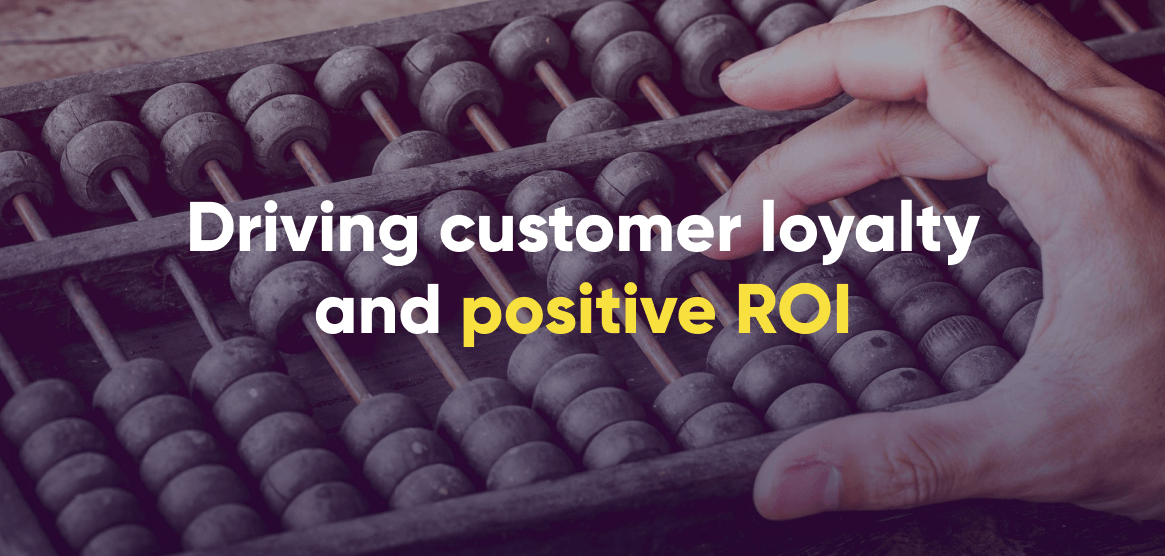In a dynamic business world like the one we have now, the promise of a high return on investment (ROI) is often the guiding light most brands follow. But is there such a thing for loyalty programs, or are they just cost centers? According to this article (and our own research), loyalty programs can yield up to 5.2X ROI. That’s why understanding your return on loyalty program investment is crucial for long-term success. But before you can review loyalty program ROI, you need to calculate it. This article and its ROI calculator will be your guiding lights for loyalty program profitability – so use them well!
Table of Contents
Avoid any miscalculation and instead plan prudently for the future with our downloadable loyalty program ROI calculator!
What Is Loyalty Program ROI and How Can You Measure It?
Loyalty programs are great at influencing customer behavior. According to Forrester, 54% of US online adults agree that loyalty programs influence what they buy, and 64% agree that programs influence where they make purchases. But how can you measure the impact and results of a rewards program? To boil it down to the basics, calculating the return on investment for your loyalty program is done by dividing the program’s profit — your revenue minus ongoing expenses — by the overall cost of the program. If this value is positive, then congratulations! Your loyalty program is making more money than it consumes.
How do you know that the uplift in orders is caused by the loyalty program and wouldn’t have happened otherwise? If you are truly curious about whether someone is loyal due to a reward program, ensure that you incentivize actions that occur outside of the buying cycle. For example, earning a coupon not only requires a valid purchase, but also needs to be claimed through a dedicated loyalty app. This ensures that a loyalty program member performs an action (downloading and signing into the app) that they would not have done as a non-member.
How much value does a loyalty program provide, and how does it translate into increased revenue? Here are a couple of ways reward programs can provide a revenue uplift:
- Loyalty program ROI improves when rewards actually reduce the customer’s dependence on discounts. Moreover, using a reward system can encourage the same behavior for a lower overall cost.
- Loyalty programs are capable of increasing both basket size and purchase frequency through dedicated features like tiers, challenges or double-point campaigns.
- Simply having a reward system has a positive effect on visitor conversion, as people want to enroll once they see the potential benefits.
- Loyalty program members form a like-minded audience. Due to targeted engagement, campaigns and offers perform better among this audience.
- Still, calculating the ROI of a loyalty program is a marathon, not a sprint. That’s because it takes customers 12-14 months to level up and gain enough benefits to start redeeming rewards.
Step 1: Calculating the Revenue for Your Loyalty Program
Just like Rome, the math behind your loyalty program’s ROI won’t be built in a day. First things first, clarify the revenue. Easy enough, right? After all, you just have to pull up your financial records, and look at the money that happy, loyal customers leave during checkout.
Think of metrics such as:
- Total transactions
- Total revenue
- Average order value
- Gross product margin
- Purchase frequency
- Membership fee (if you are running a premium or freemium program)
Of course, doing all the calculations doesn’t need to be a manual task, done by expert data analysts. Antavo’s AI-driven Optimizer helps marketers track the performance of their loyalty programs with ease and without specialized knowledge.
Step 2: Adding Up Loyalty Program Costs
Understanding your costs is essential for accurate loyalty program profitability calculations. Compared to pinpointing the incremental revenue members provide, being able to quantify program expenses is more straightforward. Regarding loyalty programs, you need to add four distinct cost types together.
1. Technology Cost
The most straightforward of the four, technology costs represent all the money you spend on the loyalty program’s backend. In other words, it’s your loyalty platform. If you choose to develop your platform in-house, it’s more difficult to predict the costs, but be prepared to foot the bill for a lot of research as well as trial and error. If you choose to go with an agency or a pure-play loyalty technology provider like Antavo, you can count on a fixed or scalable recurring fee.
On top of that, some of the following technology costs may also apply to your loyalty program’s budget:
- Licensing fee
- Implementation & integration fee
- Consulting fee
- Frontend development fee
2. People Cost
Also known as HR cost, this expense covers the total manpower working behind the loyalty program. Be aware that the people cost goes beyond the staff directly responsible for the managerial tasks like creating and running reward campaigns.
In general, the team that maintains a loyalty program with a positive loyalty program ROI should include:
- A loyalty program manager
- A CMO, who instructs the loyalty program manager
- A marketing automation manager
- An analyst who tracks the program’s performance
- For occasional, high-priority marketing activities you’ll need graphic designers, copywriters, or possibly a technical project manager
- If your program runs in physical stores, you will also need to involve your Head of Retail, an operational team, and train in-store staff
3. Marketing Cost
Your marketing budget should cover advertisement-related expenses, because the bigger the marketing push, the more likely you’ll see a high return on your loyalty program investment. This is especially true during the weeks before and after launch. In addition, spare no costs to promote the loyalty program on every possible channel. For example, ensure it is visible on your website, and make sure to promote it as part of your value offering through ads, social media, and videos.
Teaching how to measure loyalty program success and prudent program management are all part of the curriculum in Antavo’s e-learning platform, the Antavo Academy. It’s recommended for both brands planning to use Antavo, as well as partners, agencies and system integrators.
4. Rewards Cost
Compared to the previous three expenses, estimating how much your rewards will cost is a bit trickier. For starters, rewards depend on customer feedback: unpopular or unused rewards should be subtly pulled from the rewards catalog and replaced with new ones.
You also need to make several decisions about the overall direction of your reward system, all of which have an impact on the final cost. These include:
- What kind of reward types you’d like to offer: coupons, services, events, early access or content (digital or physical)
- Do you want to use your own rewards or have partner rewards as well?
- What are the logistics for each reward? Are they digitally redeemable/downloadable, or do they require physical shipping?
- Are there any manufacturing costs? Is the stock limited or unlimited?
- What is the point-to-cost ratio? Have you “priced” your reward correctly?
Step 3: Tracking Your Loyalty Program’s Success (Not Just ROI)
It’s worth highlighting that measuring loyalty program ROI shouldn’t be your sole focus. There are other important metrics that can determine whether you have the right loyalty strategy or not — especially during that critical first year when you are still waiting for reliable ROI data.
Here are some other rewards program analytics and key metrics that may help you determine your program’s success, based on our GCLR 2023 report:
- Based on our research, 44.8% of sales are made by loyalty program members. If your metrics are above this ratio, you are on the right path.
- The more points customers use, the higher your rate of engagement. Need a benchmark? Generally, 48.6% of loyalty points earned are redeemed by loyalty program members.
- Customers who use loyalty programs spend more. The average lifetime spend of customers who redeem their points at least once is 6.3x higher than the lifetime spend of non-members.
- Similarly, personalization has a positive effect on lifetime value. The average annual spend of members who redeem personalized offers is 4.5x higher than that of members who don’t.
- Using partnership rewards clearly pays off. The average annual spend of members who redeem partner offers is 3.4x higher.
How Does Antavo Help You Calculate Your Loyalty Program ROI?
As a pure-play loyalty technology provider, Antavo provides the platform and loyalty data, but the full loyalty program ROI calculation can only be done by you. Only your business has access to all the transactional data required to provide a complete figure. Nonetheless, Antavo’s Loyalty Cloud comes equipped with a series of built-in functionalities that help you analyze program performance and back your decisions with clear business metrics.
Want to learn more about Antavo’s loyalty technology and how it can bring your concept to life? Request a hands-on demonstration to further discuss the pricing plan with our experts.
Looking for a handy tool to calculate your loyalty program ROI? Make sure to download our worksheet!
Zsuzsa is the Chief Strategy Officer and Co-founder of Antavo. She has experienced Antavo grow from a startup into a market-leading, global scaleup for loyalty program technology, serving global brands and retailers. She was named Personality of the Year at the 2024 International Loyalty Awards, and listed by Forbes as one of Europe’s top 100 female founders in tech, Zsuzsa is a former journalist recognized by the European Commission.

